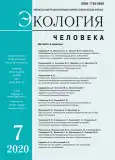QUALITY OF DRINKING WATER AND ADOLESCENTS’ TASK PERFORMANCE IN THE SOUTH OF THE RUSSIAN FAR EAST
- Authors: Koval'chuk V.K.1, Yamilova O.Y.1
-
Affiliations:
- Pacific State Medical University
- Issue: Vol 27, No 7 (2020)
- Pages: 32-39
- Section: Articles
- URL: https://journals.rcsi.science/1728-0869/article/view/42419
- DOI: https://doi.org/10.33396/1728-0869-2020-7-32-39
- ID: 42419
Cite item
Full Text
Abstract
Full Text
##article.viewOnOriginalSite##About the authors
V. K. Koval'chuk
Pacific State Medical UniversityVladivostok
O. Yu. Yamilova
Pacific State Medical University
Email: olichyamila82@gmail.com
аспирант, ассистент кафедры гигиены Vladivostok
References
- Агаджанян Н. А., Скальный А. В. Химические элементы в среде обитания и экологический портрет человека. М.: Изд-во КМК, 2001. 83 с.
- Банержи А. Медицинская статистика понятным языком: вводный курс / пер. с англ. под ред. В. П. Леонова. М.: Практическая медицина, 2014. 287 с.
- Власов В. В. Эпидемиология. М.: ГЭОТАР-МЕД, 2004. 464 с.
- Гайнутдинов М. Х., Тарасов О. Ю., Калинникова Т. Б. О влиянии марганца из питьевой воды на функции ЦНС у взрослых и детей // APRIORI. Серия: Естественные и технические науки. 2016. № 4. URL: http://apriori-journal. ru/journal-estesvennie-nauki/id/1318 (дата обращения: 26.10.2019).
- Давыдова Н. О., Нотова С. В., Кван О. В. Влияние элементного статуса организма на когнитивные функции // Микроэлементы в медицине. 2014. Т. 15, № 3. С. 3-9.
- Кику П. Ф., Бениова С. Н., Гельцер Б. И. Среда обитания и экологозависимые заболевания человека: монография / науч. ред. Хотимченко Ю. С. Владивосток: Изд-во ДФУ, 2017. 390 с.
- Ковальчук В. К., Иванова И. Л. Роль окружающей среды в возникновении неинфекционных заболеваний пищеварительной системы в Приморском крае. Владивосток: Медицина ДВ, 2013. 100 с.
- Ковальчук В. К., Иванова И. Л., Колдаев В. М. Роль окружающей среды в возникновении неинфекционных заболеваний пищеварительной системы в Приморском крае // Гигиена и санитария. 2011. № 3. С. 10-15.
- Ковальчук В. К., Маслов Д. В. Гигиенические проблемы химического состава питьевой воды систем водоснабжения Приморского края // Тихоокеанский медицинский журнал. 2006. № 3. С. 60-63.
- Ковальчук В. К., Ямилова О. Ю., Саенко А. Г. Структура суточного потребления питьевых вод подростковым населением Приморского края в 2012 и 2015 годах // Здоровье населения и среда обитания. 2017. № 6. С. 32-34.
- Копицына У. Е., Гришина Т. Р., Торшин И. Ю., Калачева А. Г., Громова О. А. Сверхнизкий уровень магния в эритроцитах как значимый фактор патогенеза пограничных психических расстройств // Журнал неврологии и психиатрии. 2015. № 11. С. 85-96.
- Минеральные воды Дальнего Востока: справочник / сост. Челнокова Б. И. Владивосток: Изд-во Дальневосточного ун-та, 2006. 108 с.
- Плитман С. И. Методологические аспекты оптимизации санитарных условий водопользования населения восточных и северных районов РСФСР: автореф. дис.. д-ра мед. наук. Москва, 1990. 42 с.
- Поляков В. Ю., Ревуцкая И. Л., Суриц О. В. Усугубление дефицита кальция и магния в питьевой воде Биробиджана при ионообменной деферризации // Экология человека. 2016. № 9. С. 3-14.
- Руководство к лабораторным занятиям по гигиене детей и подростков / Кардашенко В. И., Кондакова-Варламова Л. П., Прохорова М. В., Стромская Е. П., Степанова З. Ф.; под ред. В. Н. Кардашенко, 3-е изд. М.: Медицина, 1983. 264 с.
- Славин М. Б. Методы системного анализа в медицинских исследованиях. М.: Медицина, 1989. 304 с.
- Ставцева В. В. Динамика умственной работоспособности учащихся 4-11 классов на уроках в течение учебного дня и недели // Научные ведомости. Серия: Естественные науки. 2012. № 3. С. 166-174.
- Ямилова О. Ю., Ковальчук В. К. Среднеэксплуатационный коэффициент очистки фильтров-кувшинов «Аквафор» в природно-климатических условиях Приморского края // Материалы XIV Тихоокеанского медицинского конгресса с международным участием, г. Владивосток, 20-22 сентября 2017 г. Владивосток: Медицина ДВ, 2017. С. 121-123.
- Bjorklund G., Chartrand M. S., Aaseth J. Manganese exposure and neurotoxic effects in children // Environmental Res. 2017. Vol. 155. P 380-384.
- Cherbuin N., Kumar R., Sachdev P. S., Anstey K. J. Dietary mineral intake and risk of mild cognitive impairment: the PATH through life project // Front Aging Neurosci. 2014. Vol. 6, N 4. P 1-8.
- Koval’chuk V. K. Estimate of the providing of iron in adolescents consuming tap water with increased iron content // Am. J. Environmental Protection. 2019. Vol. 8, N 1. P 17-21.
- Kozisek F. Health risks from drinking demineralised water // Nutrients in drinking water. Geneva: WHO, 2005. P 148-163.
- Lucas R. M., McMichael A. J. Association or causation: evaluating links between «environment and disease» // Bull. World Health Organ. 2005. Vol. 83, N 10. P 792-795.
- Olivares M., Uauy R. Essential nutrients in drinking water // Nutrients in drinking water. Geneva: WHO, 2005. P 41-60.
- Oulhote Y., Mergler D., Barbeau B., Bellinger D. C., Bouffard T., Brodeur M. E., Saint-Amour D., Legrand M., Sauve S., Bouchard M. F. Neurobehavioral function in schoolage children exposed to manganese in drinking water // Environ Health Perspect. 2014. Vol. 122, N 12. P 1343-1350.
- Ozawa M., Ninomiya T., Ohara T., Hirakawa Y., Doi Y., Hata J. Self-reported dietary intake of potassium, calcium, and magnesium and risk of dementia in the Japanese: the Hisayama study // J. Am. Geriatr. Soc. 2012. Vol. 60, N 8. P 1515-1520.
- Penke L., Hernandez M. C., Maniega S., Gow A. J., Murray C., Starr J. M., Bastin M. E., Deary I. J., Wardlaw J. M. Brain iron deposits are associated with general cognitive ability and cognitive aging // Neurobiol. Aging. 2012. Vol. 33, N 3. P. 510-517.
- Wang C.-T., Li Y. J., Wang F.-J., Shi Y.-M., Lee B.-T. Correlation between the iron, magnesium, potassium and zinc content in adolescent girls’ hair and their academic records // Chang Gung Med J. 2008. Vol. 31, N 4. P 358-363.
- World Health Organization. Guidelines for drinking water quality. 4-th ed. Geneva: WHO, 201 1. 541 p.
- World Health Organization. Nutrients in drinking water. Geneva: WHO, 2005. 196 p.
Supplementary files







